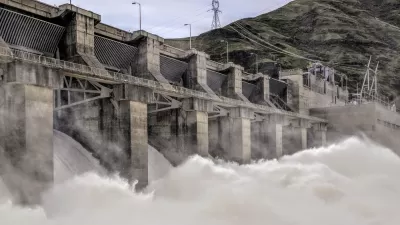Dam removal has its benefits, according to the example set by a particularly historic dam removal in the United States, which took place on July 1, 1999.

The first time the federal government ordered the removal of dam removed happened 20 years ago on the Kennebec River in Maine.
The reason for the removal of the Edwards Dam, according to an article by Amy Souers Kober: the dam's costs outweighed its benefits.
Souers Kober celebrates that historic milestone in water infrastructure and river restoration by cataloguing some of the country's greatest dam removal successes in the ensuing decades—and there were plenty of options to choose from, especially of late.
"According to the dam removal database maintained by American Rivers, 1,605 dams have been removed in the U.S. since 1912," according to the article. "Most of these (1,199) have occurred since the removal of Edwards Dam in 1999. The year with the most dam removals was 2018 (99 dams removed). 2017 was the second most productive year, with 91 dams removed."
For records of success, Souers Kober doesn't have to look beyond that first example: "Our partners at the Natural Resources Council of Maine report that since Edwards Dam was removed on July 1, 1999, tens of millions of alewives, blueback herring, striped bass, shad, and other sea-run fish have traveled up the Kennebec River, past the former Edwards Dam, which blocked upstream passage since 1837. Abundant osprey, bald eagles, sturgeon and other wildlife have also returned."
But the article doesn't stop with that first example, surveying the nation's regions for more recent examples of design removal success. American Rivers also provides an interactive map of dam removals for more exploring.
FULL STORY: TWENTY YEARS OF DAM REMOVAL SUCCESSES – AND WHAT’S UP NEXT

Alabama: Trump Terminates Settlements for Black Communities Harmed By Raw Sewage
Trump deemed the landmark civil rights agreement “illegal DEI and environmental justice policy.”

Study: Maui’s Plan to Convert Vacation Rentals to Long-Term Housing Could Cause Nearly $1 Billion Economic Loss
The plan would reduce visitor accommodation by 25% resulting in 1,900 jobs lost.

Why Should We Subsidize Public Transportation?
Many public transit agencies face financial stress due to rising costs, declining fare revenue, and declining subsidies. Transit advocates must provide a strong business case for increasing public transit funding.

Paris Bike Boom Leads to Steep Drop in Air Pollution
The French city’s air quality has improved dramatically in the past 20 years, coinciding with a growth in cycling.

Why Housing Costs More to Build in California Than in Texas
Hard costs like labor and materials combined with ‘soft’ costs such as permitting make building in the San Francisco Bay Area almost three times as costly as in Texas cities.

San Diego County Sees a Rise in Urban Coyotes
San Diego County experiences a rise in urban coyotes, as sightings become prevalent throughout its urban neighbourhoods and surrounding areas.
Urban Design for Planners 1: Software Tools
This six-course series explores essential urban design concepts using open source software and equips planners with the tools they need to participate fully in the urban design process.
Planning for Universal Design
Learn the tools for implementing Universal Design in planning regulations.
Smith Gee Studio
Alamo Area Metropolitan Planning Organization
City of Santa Clarita
Institute for Housing and Urban Development Studies (IHS)
City of Grandview
Harvard GSD Executive Education
Toledo-Lucas County Plan Commissions
Salt Lake City
NYU Wagner Graduate School of Public Service





























